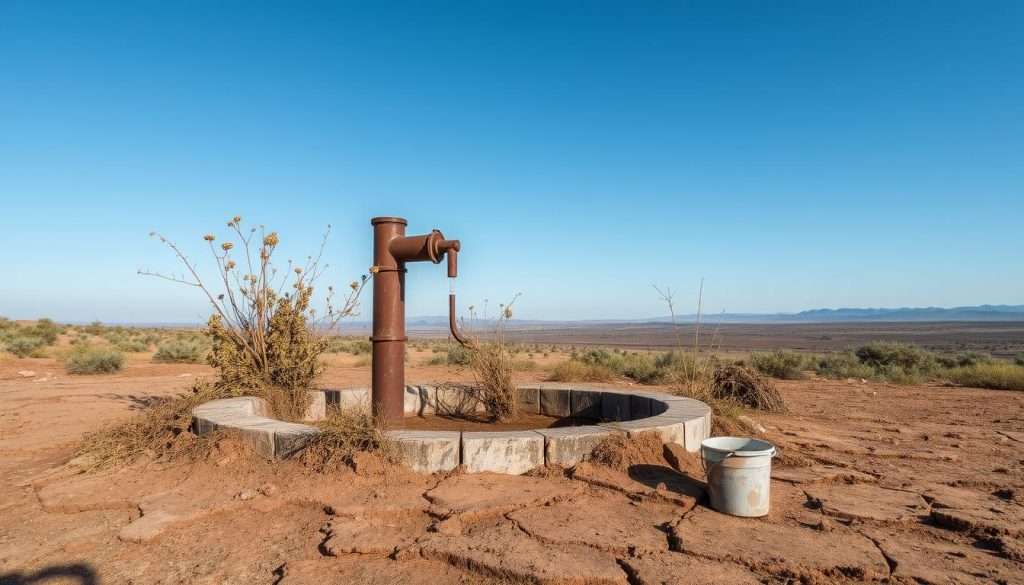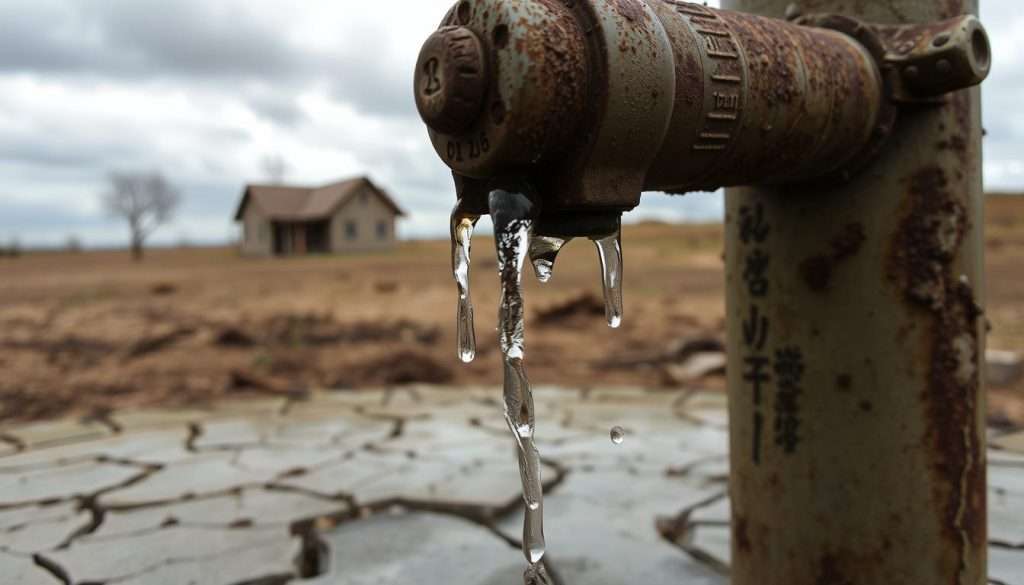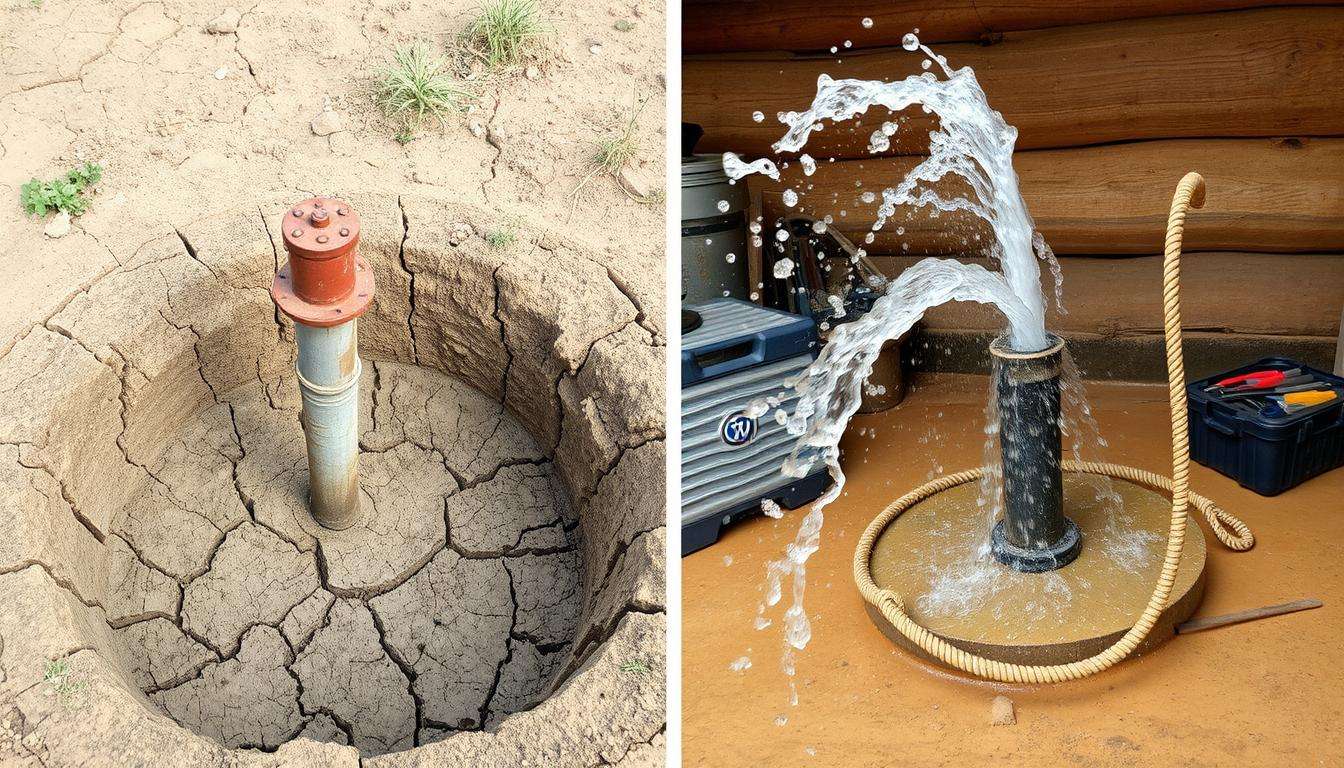Homeowners and DIY fans need to know if their well is dry or if the pump is broken. There are signs to tell if your well is dry or if your pump is not working right. Knowing these signs early can save you money and keep your water safe.
We will talk about how wells work. This includes checking water levels and quality, and noticing changes in how the system works. This info will help you fix problems and keep your water flowing well.
Key Takeaways
- Identify signs of dry well versus bad pump to maintain water supply.
- Common indicators include sudden water pressure decline and unusual pump noises.
- Regular maintenance can prevent costly repairs and extend pump life.
- Understanding pump specifications helps in diagnosing well issues.
- Early intervention can avoid expensive well drilling or replacement.
Understanding Well Functionality
To understand wells, we need to know how they work and their parts. Wells bring up groundwater from deep holes. They tap into aquifers, which are big water stores. This shows how important wells are for homes.
How Wells Work: A Brief Overview
Wells get water from aquifers. About 37 percent of home water comes from wells. Modern wells can go over 1,000 feet deep. This lets them find fresh water deep down.
- The well is drilled into the aquifer, tapping into a natural water source.
- A pump draws water from the well to the surface for household use.
- Seasonal changes in rain and drought affect water levels, so management is key.
Common Components of a Well System
Knowing well parts helps us see how they work well. Here’s a table of key parts and what they do:
| Component | Function |
|---|---|
| Well Casing | Protects the well from contamination and supports the structure. |
| Well Cap | Prevents debris and contaminants from entering the well. |
| Well Screen | Filters out sediment while allowing water to flow through. |
| Pitless Adapter | Connects the well with the household plumbing system. |
| Jet Pump | Pumps water from shallow wells to the surface. |
| Submersible Pump | Designed to be submerged in the well, it efficiently lifts water to the surface. |
Knowing these parts and how they work helps us understand wells better. It prepares us to fix any problems. Keep this info ready for good well care.
Signs Your Well Might Be Dry
Having enough water is key for any home with a well. Knowing the signs early can help. This way, you can fix the problem before it gets worse. Here are some signs your well might be dry.
Sudden Decline in Water Pressure
A drop in water pressure is a big sign. You might see water trickling instead of flowing well. This happens when the water table goes down.
Look out for:
- Gurgling or sputtering from faucets.
- Reduced pressure leading to weak streams of water.
- Water recovery issues after heavy usage, indicating reduced availability.
Changes in Water Quality
Also, watch for changes in water quality. Bad taste or smell means your well might be drying up. You might see:
- Presence of sand and mud in the water, suggesting sediment intrusion.
- Appearance of bubbles from dissolved gases, such as carbon dioxide.
- An unusual taste or odor that wasn’t present before.
Increased Pump Running Time
Check how often your water pump runs. If it runs more, it’s a sign of low water. This can make your electricity bill go up. Look for:
- A significant rise in power usage reflected in your electricity bill.
- Frequent cycling of the pump, which may indicate it’s unable to maintain pressure.
- A consistent drop in water levels during peak usage.

Indicators of a Faulty Pump
Knowing when your pump is bad is key to keeping water flowing well. To fix your pump, first, learn what signs to look for. Here are some warning signs to check your well pump’s health.
Unusual Noises from the Pump
Strange sounds like grinding or rattling mean trouble. Electric motors should be quiet. Any noise means you should check it fast. Ignoring it could cause more damage and a total pump failure.
Pump Cycling Frequently
When the pump cycles a lot, it might be a sign of a problem. This could be because the pressure tank bladder failed. It puts too much stress on the motor. This cycling can make your bills go up and shorten your pump’s life. Watch how often your pump cycles.
Inconsistent Water Flow
Water flow that changes suddenly is a big warning sign. You might see water pressure go up and down. This means your pump is having trouble working right. It could be because of leaks or other problems. Fixing it fast is important to avoid big repairs.

| Indicator | Possible Cause | Impact |
|---|---|---|
| Unusual Noises | Internal damage or misalignment | Potential pump failure |
| Frequent Cycling | Failed pressure tank bladder | Increased utility bills, reduced lifespan |
| Inconsistent Water Flow | Leaks or pump struggle | Disrupted water supply, possible repairs |
Fixing these problems quickly can save you from big repairs. Regular checks and watching for these signs can help. Taking action now can stop bigger problems later.
Troubleshooting Your Water Supply
Dealing with well problems can feel scary. But, you can do some simple checks to figure out what’s wrong. If your well is dry or your pump is broken, you can spot problems early. This way, you won’t need to call for help right away.
Basic Diagnostic Steps to Take
First, check how your water supply is doing. Here are some steps to help you troubleshoot:
- Check Water Pressure: A big drop in water pressure might mean your pump or well has a problem.
- Inspect Pump Cycling: If your pump keeps turning on and off, it could have a bad check valve.
- Observe Water Quality: If your water looks different, smells bad, or has sand, it’s a sign of a bigger issue.
- Look for Air in Pipes: Seeing air bubbles means there might be leaks or drainage problems.
When to Call a Professional
While trying to fix your well or pump is good, knowing when to ask for help is key. You should call a pro if:
- Your checks show ongoing problems.
- Water pressure still isn’t right, even after trying to fix it.
- You keep getting bad water quality reports.
- Your electricity bill goes up a lot because of your pump.
Experts like Weeks Drilling & Pump Co. are great at fixing well problems. If you’re worried about your water, don’t wait to call them.
Preventative Measures for Well Maintenance
Keeping your well system working well needs regular care. By following certain steps, you can avoid big problems and expensive fixes. It’s important to check your well often and stick to a maintenance plan.
Regular Inspections and Testing
Doing regular well inspections helps find issues early. Try to check your well once a year. This should include:
– Bacteria testing
– Flow evaluation
– Pressure switch analysis
– Pump amps test.
Also, test your water often for bad stuff. If your water looks, tastes, or smells off, get it checked right away. For more tips on well care, check out well maintenance guidelines.
Recommended Maintenance Practices
Follow these well care practices for a steady water supply:
– Clean your well often to stop contamination.
– Refresh your well every ten years to keep water good.
– Change the pressure tank every ten years to keep water pressure right.
These steps help your system work well and last longer. Remember, taking care of your well is important. With the right steps, you can have safe, clean water for a long time.
